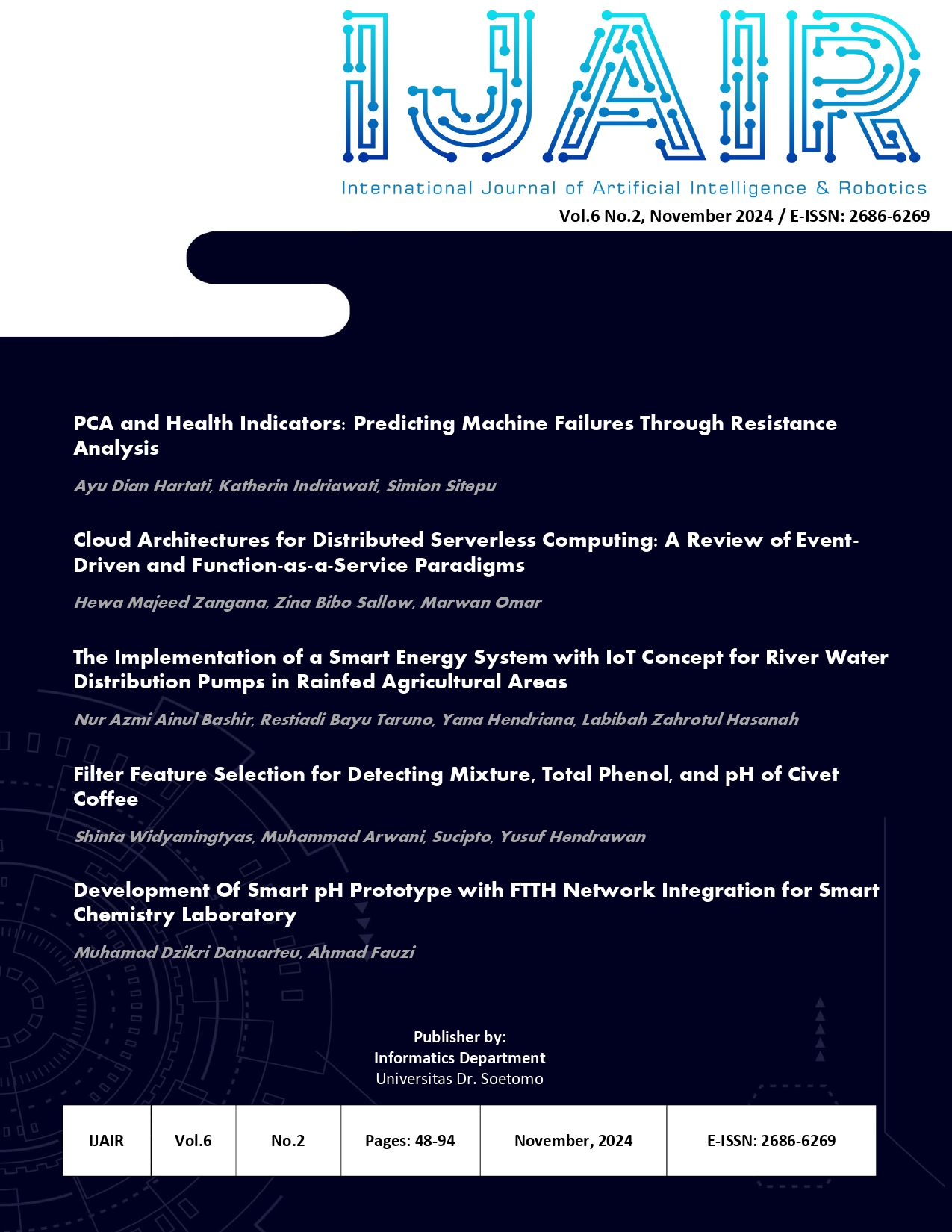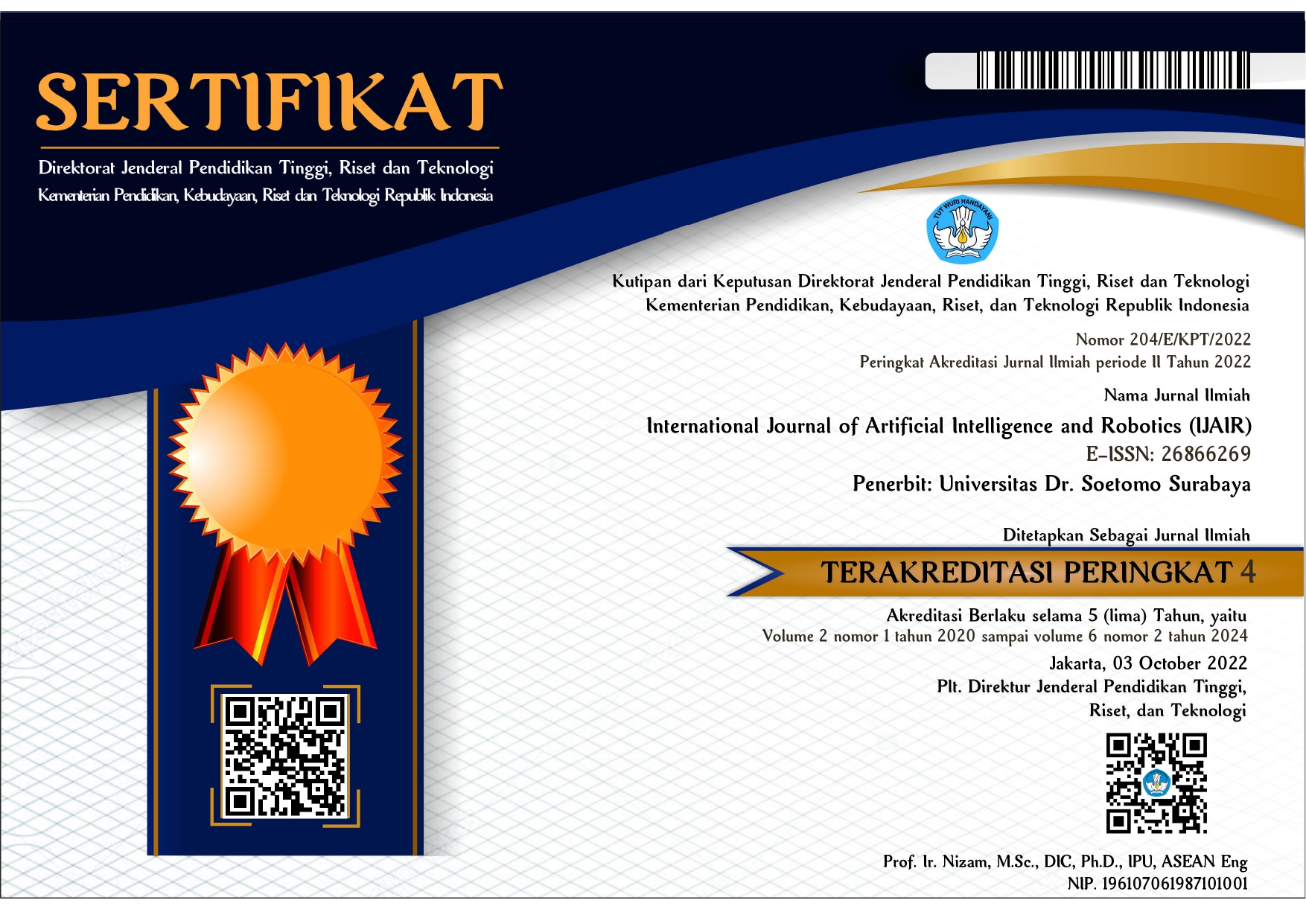Development Of Smart pH Prototype with FTTH Network Integration for Smart Chemistry Laboratory
 Abstract views: 191
,
Abstract views: 191
,
 PDF downloads: 140
PDF downloads: 140
Abstract
Chemistry laboratories at the secondary education level have a vital role in supporting learning and research. However, manual management often faces obstacles in efficiency, accuracy, and data accessibility. Following the Regulation of the Minister of National Education Number 24 of 2007, pH meters are mandatory equipment in high school chemistry laboratories. However, conventional tools are often inadequate for precise real-time measurements. This study developed a Smart pH system integrating the Internet of Things (IoT) and fiber-to-the-home (FTTH) technology for real-time pH measurement. This system was designed using a pH-4502C sensor, Arduino Uno, NodeMCU ESP8266, and Arduino Cloud and tested on five types of solutions relevant to the high school chemistry curriculum, including salt solution, vinegar, lime, liquid soap, and mineral water. The test results showed an average accuracy of 99% and a 1-1.6 seconds data transmission delay. The total loss of the FTTH network was 3.65 dB, within the ITU-T G.984 standard limit. This research supports the fulfillment of national standards and improves the efficiency and reliability of pH measurements, opening up opportunities for further innovation in chemistry education laboratory automation in Indonesia.
Downloads
References
F. Wibowo et al., “Penerapan Smart Laboratory Berbasis Internet of Things untuk Meningkatkan Keamanan dan Keselamatan di Laboratorium Komputer Universitas Muhammadiyah Pontianak,†-Com Indones. Community J., vol. 4, no. 1, pp. 158–168, Mar. 2024, doi: 10.33379/icom.v4i1.3961.
M. L. Comeaga, "Digital transformation of the laboratories," IOP Conf. Ser. Mater. Sci. Eng., vol. 1268, no. 1, p. 012001, Nov. 2022, doi: 10.1088/1757-899X/1268/1/012001.
A. N. Khomarudin, R. Novita, and R. Aulia, "Pengembangan Smart Laboratory Melalui Aplikasi Presensi Sebagai Bentuk Monitoring Kehadiran Dosen Dalam Kegiatan Praktikum," Device, vol. 13, no. 2, pp. 168–176, Nov. 2023, doi: 10.32699/device.v13i2.5697.
J. Li et al., "Smart heightened-containment biological laboratory: Technologies, modules, and aims," J. Biosaf. Biosecurity, vol. 4, no. 2, pp. 89–97, Dec. 2022, doi: 10.1016/j.jobb.2022.06.003.
V. R. D. Al Aziz, H. Zarory, P. S. Maria, and A. Faizal, “Prototype Pengukuran Kadar Alkohol dan Co Pada Ruangan Laboratorium Pendidikan Kimia Berbasis IoT,†Build. Inform. Technol. Sci., vol. 6, no. 1, pp. 138–145, 2024, doi: 10.47065/bits.v6i1.5328.
Ahmad Iqbal Addzikri and Firra Rosariawari, “Analisis Kualitas Air Permukaan Sungai Brantas Berdasarkan Parameter Fisik dan Kimia,†INSOLOGI J. Sains Dan Teknol., vol. 2, no. 3, pp. 550–560, Jun. 2023, doi: 10.55123/insologi.v2i3.1981.
Kementerian Pendidikan dan Kebudayaan, “Peraturan Menteri Pendidikan Nasional Republik Indonesia Nomor 24 Tahun 2007 Tentang Standar Sarana Dan Prasarana Untuk Sekolah Dasar/Madrasah Ibtidaiyah (Sd/Mi), Sekolah Menengah Pertama/Madrasah Tsanawiyah (Smp/Mts), Dan Sekolah Menengah Atas/Madrasah Aliyah (Sma/Ma),†2007, [Online]. Available: https://repositori.kemdikbud.go.id/18715/1/Permendiknas-No.-24-tahun-2007.pdf
D. Adhav, R. Pagar, R. S. | S. Tawade, and Department of Computer Engineering, MET's Institute of Engineering, Nashik, Maharashtra, India, "Smart Laboratory," Int. J. Trend Sci. Res. Dev., vol. Volume-3, no. Issue-3, pp. 504–509, Apr. 2019, doi: 10.31142/ijtsrd22840.
H. Herlina and D. I. Muthawali, “Pemanfaatan Teknologi Internet of Things (IoT) dalam Laboratorium Kimia,†Fields Sci. J. Liaison Acad. Sosiety, vol. 3, no. 4, pp. 12–16, Dec. 2023, doi: 10.58939/afosj-las.v3i4.681.
M. Irsal and Y. Saragih, “perancangan jaringan fiber to the home (FTTH) menggunakan aplikasi google earth pro,†Aisyah J. Inform. Electr. Eng. AJIEE, vol. 5, no. 1, pp. 49–57, Feb. 2023, doi: 10.30604/jti.v5i1.133.
N. A. Mohd Jais, A. F. Abdullah, M. S. Mohd Kassim, M. M. Abd Karim, A. M, and N.' Atirah Muhadi, "Improved accuracy in IoT-Based water quality monitoring for aquaculture tanks using low-cost sensors: Asian seabass fish farming," Heliyon, vol. 10, no. 8, p. e29022, Apr. 2024, doi: 10.1016/j.heliyon.2024.e29022.
K. S. Bu'u, N. Nachrowie, and E. Sonalitha, "Monitoring Kualitas Air pada Aquarium Berbasis Internet of Things (IoT)," Blend Sains J. Tek., vol. 2, no. 2, pp. 184–190, Oct. 2023, doi: 10.56211/blendsains.v2i2.321.
A. Lestari and A. Zafia, “Penerapan Sistem Monitoring Kualitas Air Berbasis Internet Of Things,†LEDGER J. Inform. Inf. Technol., vol. 1, no. 1, pp. 17–24, Feb. 2022, doi: 10.20895/ledger.v1i1.776.
F. Chuzaini and Dzulkiflih, “IoT Monitoring Kualitas Air Dengan Menggunakan Sensor Suhu, Ph, Dan Total Dissolved Solids (TDS),†J. Inov. Fis. Indones. IFI, vol. 11, no. 3, pp. 46–56, 2022.
R. P. Shete, A. M. Bongale, and D. Dharrao, "IoT-enabled effective real-time water quality monitoring method for aquaculture," MethodsX, vol. 13, p. 102906, Dec. 2024, doi: 10.1016/j.mex.2024.102906.
Z. Abdellaoui, Y. Dieudonne, and A. Aleya, "Design, implementation and evaluation of a Fiber To The Home (FTTH) access network based on a Giga Passive Optical Network GPON," Array, vol. 10, p. 100058, Jul. 2021, doi: 10.1016/j.array.2021.100058.
Okpatrioka, “Research And Development (R&D) Penelitian Yang Inovatif Dalam Pendidikan,†DHARMA ACARIYA Nusant. J. Pendidik. Bhs. Dan Budaya, vol. 1, no. 1, pp. 86–100, 2023.
S. Islamy, W. R. Gusti, and M. Zakarijah, “Penerapan IoT Pada Prototipe Pengukur Tekanan Darah Non-Invasive Berbasis ESP8266,†JST J. Sains Dan Teknol., vol. 12, no. 3, pp. 823–832, Jan. 2024, doi: 10.23887/jstundiksha.v12i3.56356.
A. R. Azhar, D. A. Setiawan, N. A. A. Yasmin, T. A. Putri, and G. F. Nama, “Sistem Monitoring Kapasitas Air Dan Pengisian Otomatis Berbasis Iot Menggunakan Modul Esp8266,†J. Inform. Dan Tek. Elektro Terap., vol. 12, no. 1, Jan. 2024, doi: 10.23960/jitet.v12i1.3966.
M. N. Ikhsanto and A. Setiawan, “Jaringan Akses Fiber To The Home (FTTH) Dengan Teknologi Gigabyte Passive Optical Network (GPON) PT. Telkom Kota Metro,†J. Comput. Sci. Inf. Syst. J-Cosys, vol. 4, no. 1, pp. 57–63, Feb. 2024, doi: 10.53514/jco.v4i1.497.
A. Hindayani, F. I. Permatasari, and A. S. Putri, Panduan Pengukuran pH dengan Teknik Kalibrasi Dua Titik. Badan Standardisasi Nasional, 2022.
G. Yuliana, H. Dianhar, and A. Suhendar, Kimia SMA/MA Kelas XII. Jakarta: Kementerian Pendidikan, Kebudayaan, Riset, dan Teknologi, 2022.
Copyright (c) 2024 Muhamad Dzikri Danuarteu, Ahmad Fauzi

This work is licensed under a Creative Commons Attribution-ShareAlike 4.0 International License.
Authors who publish with International Journal of Artificial Intelligence & Robotics (IJAIR) agree to the following terms:
-
Authors retain copyright and grant the journal right of first publication with the work simultaneously licensed under a Creative Commons Attribution License (CC BY-SA 4.0) that allows others to share the work with an acknowledgment of the work's authorship and initial publication in this journal.
-
Authors are able to enter into separate, additional contractual arrangements for the non-exclusive distribution of the journal's published version of the work (e.g., post it to an institutional repository or publish it in a book), with an acknowledgment of its initial publication in this journal.
-
Authors are permitted and encouraged to post their work online (e.g., in institutional repositories or on their website) prior to and during the submission process, as it can lead to productive exchanges, as well as earlier and greater citation of published work.















